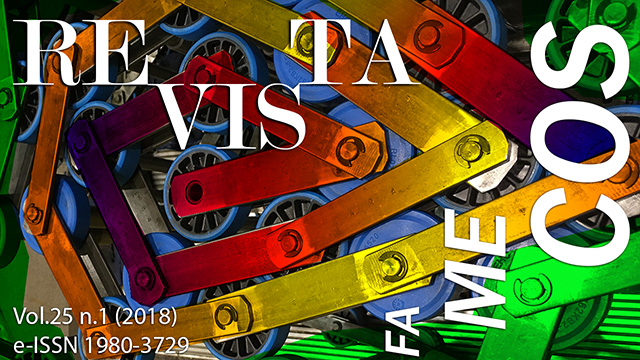Reflections about "the woman", the look and the racial question in the feminist film theory
DOI:
https://doi.org/10.15448/1980-3729.2018.1.26788Keywords:
Feminist film theory, Black women, Gender and RaceAbstract
Since the 1970s, the representations of women in the cinema have been object of criticism of the feminist theorists, that emphasize the relevance of the classic narrative cinema as product and producer of the patriarchal imaginary. However, anchored in a psychoanalytic perspective, this theoretical aspect presents some limitations, such as the emphasis on the white woman as model of femininity and the binary construction of visual pleasure. In this article, based on studies that discuss the historical experience of black women, we seek to problematize the intersection of gender and race as determinant in the systems of representation, in the construction of visual pleasure and in modes of filmic reception, which indicates new possibilities for the recognition of black women in the feminist film theory.
Downloads
References
BOBO, Jacqueline. The color purple: black women as cultural readers. In: PRIBRAM, Deidre. Female spectators: looking at film and television. London: Verso,1988. p. 90-109.
BORDWELL, David. O cinema clássico hollywoodiano: normas e princípios narrativos. In: RAMOS, Fernão P. (Org.). Teoria contemporânea do cinema: documentário e narratividade ficcional. v. 2. São Paulo: Senac, 2005. p. 277-302.
GAINES, Jane. White privilege and looking relations: race and gender in feminist film theory. In: THORNHAM, Sue (Ed.). Feminist film theory: a reader. Edinburgh: Edinburgh University Press, 1999. p. 293-306.
HAYWARD, Susan. Cinema studies: the key concepts. 2 ed. London: Routledge, 2000.
hooks, Bell. The oppositional gaze. In: ______. Black looks: race and representation. London: Turnaround, 1992. p. 115-131.
KAPLAN, Elizabeth. A mulher e o cinema: os dois lados da câmera. Tradução de Helen Marcia Potter Pessoa. Rio de Janeiro: Rocco, 1995.
MALUF, Sônia W.; MELLO, Cecilia A. de; PEDRO, Vanessa. Políticas do olhar: feminismo e cinema em Laura Mulvey. Revista Estudos Feministas, Florianópolis, v. 13, n. 2, p. 343-350, 2005. DOI: https://doi.org/10.1590/S0104-026X2005000200007.
McCABE, Janet. Feminist film studies: writing the woman into cinema. London: Wallflower, 2004.
MODLESKI, Tania. Cinema and the dark continent: race and gender in popular film. In: THORNHAM, Sue (Ed.). Feminist film theory: a reader. Edinburgh: Edinburgh University Press, 1999. p. 321-335.
MULVEY, Laura. Visual pleasure and narrative cinema. Screen, v. 16, n. 3, p. 6-18,1975.
______. Prazer visual e cinema narrativo. In: XAVIER, Ismail (Org.). A. Experiência do cinema. Rio de Janeiro: Edições Graal; Embrafilme, 1983. p. 435-454.
______. Reflexões sobre “Prazer visual e cinema narrativo” inspiradas por Duelo ao Sol, de King Vidor (1946). Tradução de Silvana Vieira. In: RAMOS, Fernão P. (Org.). Teoria contemporânea do cinema: pós-estruturalismo e filosofia analítica. v. 1. São Paulo: Senac, 2005. p. 381-392.
OLIVEIRA FILHO, José H. O cinema narrativo, a psicanálise e o feminismo sob a perspectiva de Laura Mulvey. Revista Habitus, Rio de Janeiro, v. 10, n. 1, p. 38-49, 2012.
RIBEIRO, Djamila. Postura incômoda. Sesc 70 Anos, São Paulo, 30 jul. 2015. Disponível em: http://www.sescsp.org.br/online/artigo/9242_NOVO+FEMINISMO. Acesso em: 12 jan. 2015.
STAM, Robert. Introdução à teoria do cinema. Campinas; São Paulo: Papirus, 2003.
XAVIER, Ismail. O olhar e a cena. São Paulo: Cosac & Naify, 2003.
______. O discurso cinematográfico: a opacidade e a transparência. São Paulo: Paz e Terra, 2005.
YOUNG, Lola. Fear of the dark: race, gender and sexuality in the cinema. London: Routledge, 1996a.
______. The rough side of the mountain: black women and representation in film. In: JARRETT-MACAULEY, Delia (Ed.). Reconstructing womanhood, reconstructing feminism: writings on black women. London: Routledge, 1996b. p. 177-202.
Downloads
Published
How to Cite
Issue
Section
License
Copyright
The submission of originals to Revista Famecos implies the transfer by the authors of the right for publication. Authors retain copyright and grant the journal right of first publication. If the authors wish to include the same data into another publication, they must cite Revista Famecos as the site of original publication.
Creative Commons License
Except where otherwise specified, material published in this journal is licensed under a Creative Commons Attribution 4.0 International license, which allows unrestricted use, distribution and reproduction in any medium, provided the original publication is correctly cited.






